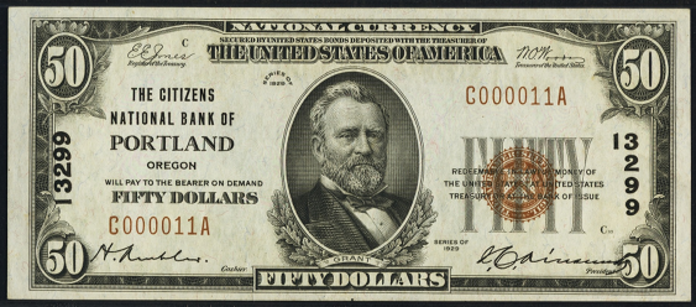Fifty Dollar Notes › Nationals › 1929 Fifty Dollar National Bank Notes › Illinois Charters › 1929 $50 Homer Illinois First National Bank
Get Value Now
| Item | Info |
|---|---|
| Series | 1929 |
| Charter | #2965 First National Bank of Homer, Illinois |
| Year Chartered | 1883, 252 Banks Chartered |
| City Info | Homer is a village in Champaign County, Illinois, United States. Its population was 1,193 at the 2010 census. Homer grew from a settlement named Union, which was on the Fort Clark or State Road running between Danville and Urbana, nearly three miles north of the present town. Union was little more than several cabins built in 1829-30, but it served as a post office and meeting place in what was Vermilion County prior to the creation of Champaign County in 1833. Moses Thomas, a native of Pennsylvania, built a mill on the Salt Fork creek southeast of Union in 1834 and began to mill grain. A young merchant traveling from Indiana, Michael Doctor Coffeen, built a store adjacent to the mill, and with Thomas created the village of Homer on January 26, 1837. The post office was moved to Homer with M. D. Coffeen as postmaster in 1841. Source: Wikipedia |
| Similar Cities | If your note doesn't match try: 1. Homer, Louisiana - Homer National Bank 2. Homer City, Pennsylvania - Homer City National Bank 3. Homer, Louisiana - American National Bank 4. Homer, Louisiana - Commercial National Bank 5. Homer, Illinois - First National Bank |
| Seal Varieties | Small Brown |
| See Also | If your note doesn't match try: 1. 1929 $50 Federal Reserve Bank Note 2. 1928 $50 Federal Reserve Note 3. 1928A $50 Federal Reserve Note 4. 1934 $50 Federal Reserve Note 5. 1934A $50 Federal Reserve Note 6. 1934B $50 Federal Reserve Note |
| Other Info | 1. Value depends on notes known for charter, condition and market demand. |
| Neat Fact | Check your note's serial number. Serial #1 notes are valuable, even on common charters. Serial numbers 2-4 are also desirable in some cases. |
No Obligations Offers and Appraisals
Please submit a good photo or scan. It will be identified and evaluated. Understand there may be subtle differences between the image you see above and your note. Signatures, design, markings and note condition will determine the offer price. Notes in Uncirculated or better condition receive the best offers.
Appraisals can be estimated for wholesale and retail prices. Wholesale is what dealers typically pay. Retail is what a collector might pay. Retail is slightly higher in most cases.
Please visit this page for USA Paper Money Reference. Do not treat this page as a reference guide, it is for appraisal and acquisition purposes only.
